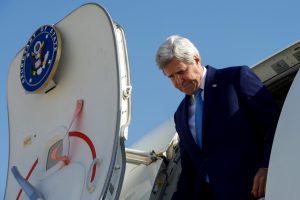John Kerry, formerly the U.S. secretary of state and now special presidential envoy for climate, was in Shanghai from April 14 to 17 to discuss climate issues. It was the first high-level visit by a Biden administration official to China, a sign of the high-profile role climate issues play in the relationship. During his visit, Kerry met with his counterpart, China’s Special Envoy for Climate Xie Zhenhua, as well as with Vice Premier Han Zheng, a member of China’s top political body, the Politburo Standing Committee.
“During the talks, the two sides had candid, in-depth and constructive communication on climate change cooperation, the Leaders Summit on Climate, COP26 of the UNFCCC and achieved positive progress,” Foreign Ministry spokesperson Wang Wenbin said in a press briefing on April 19. “They reopened the channel of dialogue and cooperation on climate change between China and the US.”
He added, “The two sides will continue to maintain communication and dialogue and strengthen exchanges and cooperation in such areas as making stronger policies and measures, promoting green, low-carbon transition and supporting low-carbon energy development in developing countries.”
According to a statement from China’s Ministry of Ecology and Environment, China and the United States “also vowed to hammer out a long-term strategy for realizing carbon neutrality and net zero emissions of greenhouse gases before COP 26,” which will take place in November 2021 in Glasgow, the U.K. China’s President Xi Jinping announced China would aim for net-zero emissions by 2060 in a surprise statement last fall, while the Biden administration has set 2050 as the target date for the U.S. to achieve the same goal.
The joint statement issued after Kerry’s trip pledged three specific actions for China-U.S. climate cooperation “in the short term.” First, as mentioned above, both sides will lay out their long-term strategies for meeting previously made targets for reaching net-zero emissions.
Second, “Both countries intend to take appropriate actions to maximize international investment and finance in support of the transition from carbon-intensive fossil fuel based energy to green, low-carbon and renewable energy in developing countries.” This could be a crucial area of cooperation, if China and the United States work together to fund a green transition in the developing world. Currently, China is one of the world’s leading investors in coal power plants abroad, and the United States has mostly framed investments in renewable energy as an alternative to the Chinese option, raising the geopolitical costs for third countries. If, instead, the two sides cooperated on such projects there would undoubtedly be many more interested recipients.
Finally, both China and the U.S. pledged to continue to phase out hydrofluorocarbon production and consumption in accordance with the Kigali Amendment to the Montreal Protocol.
The statement also pledged further discussions on “concrete actions in the 2020s to reduce emissions aimed at keeping the Paris Agreement-aligned temperature limit within reach,” including on renewable energy technology (including hydrogen power and carbon capture), green transportation options, and climate resilient agriculture, among other areas.
During the previous Obama administration in the United States, climate change was an important part of the China-U.S. relationship, highlighted by a crucial bilateral agreement on climate change that paved the way to the global Paris Agreement of 2015. But Obama’s successor, President Donald Trump, withdrew the United States from the Paris climate deal and downplayed climate change mitigation efforts. Climate cooperation under Trump thus withered even before the rest of the relationship frayed at the seams amid the trade war and the COVID-19 pandemic. Meanwhile, the Xi administration in China went in the opposite direction, adopting environmental protection as one of its key governing goals.
Kerry’s visit puts climate change firmly back on the China-U.S. agenda. It may be one of the few areas where the two sides can truly cooperate – if they can keep other areas of tension from bleeding in. That’s no easy task, given that one of the crucial elements of any climate change strategy is the pursuit of clean energy technology, which folds into the broader China-U.S. competition for technological leadership across a variety of fields.
The joint statement also said that “Both countries look forward to the US-hosted Leaders Summit on Climate on April 22/23.” However, China’s Foreign Ministry refused to confirm whether or not Xi would take part in the virtual summit later this week.
“The Chinese side has received invitation from the U.S. side, and is positively looking into that,” was all Foreign Ministry spokesperson Wang would say when asked about Xi’s attendance.































